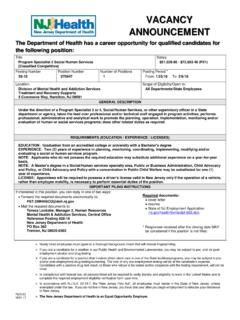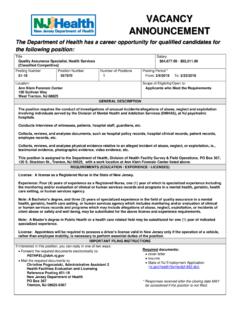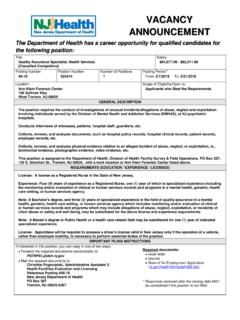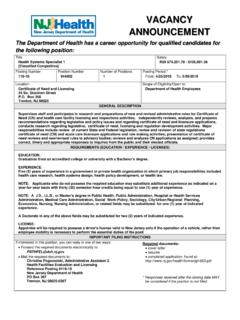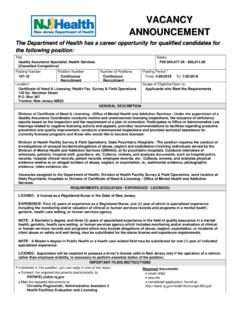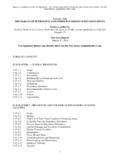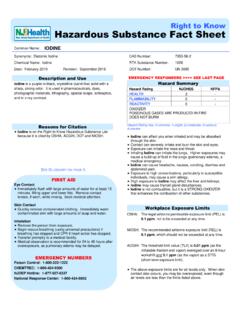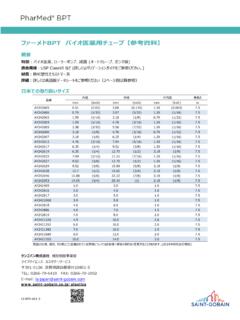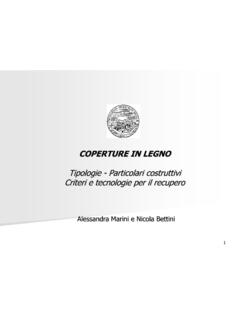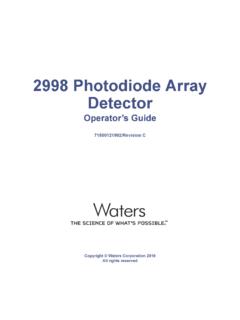Transcription of Right to Know Hazardous Substance Fact Sheet
1 Right to Know Hazardous Substance Fact Sheet Common Name: sodium hypochlorite Synonyms: Clorox; Liquid Bleach; sodium Oxychloride Chemical Name: Hypochlorous Acid, sodium Salt Date: April 2000 Revision: September 2008 CAS Number: 7681-52-9 RTK Substance Number: 1707 DOT Number: UN 1791 Description and Use sodium hypochlorite is a clear, slightly yellow or green liquid with a strong Chlorine odor. It is usually mixed in water and used as a household cleaner, a disinfectant, and a bleaching agent. It is also used in water treatment and purification. Reasons for Citation f sodium hypochlorite is on the Right to Know Hazardous Substance List because it is cited by DOT, IARC and EPA. f This chemical is on the Special Health Hazard Substance List. SEE GLOSSARY ON PAGE 5. FIRST AID Eye Contact f Immediately flush with large amounts of water for at least 30 minutes, lifting upper and lower lids.
2 Remove contact lenses, if worn, while flushing. Seek medical attention immediately. Skin Contact f Quickly remove contaminated clothing. Immediately wash contaminated skin with large amounts of water. Seek medical attention. Inhalation f Remove the person from exposure. f Begin rescue breathing (using universal precautions) if breathing has stopped and CPR if heart action has stopped. f Transfer promptly to a medical facility. f Medical observation is recommended for 24 to 48 hours after overexposure, as pulmonary edema may be delayed. EMERGENCY NUMBERS Poison Control: 1-800-222-1222 CHEMTREC: 1-800-424-9300 NJDEP Hotline: 1-877-927-6337 National Response Center: 1-800-424-8802 EMERGENCY RESPONDERS >>>> SEE BACK PAGE Hazard Summary Hazard Rating NJDOH NFPA HEALTH 3 - FLAMMABILITY 0 - REACTIVITY 0 - CORROSIVE POISONOUS GASES ARE PRODUCED IN FIRE Hazard Rating Key: 0=minimal; 1=slight; 2=moderate; 3=serious; 4=severe f sodium hypochlorite can affect you when inhaled.
3 F Contact can severely irritate and burn the skin and eyes with possible eye damage. f Inhaling sodium hypochlorite can irritate the nose and throat. f Inhaling sodium hypochlorite can irritate the lungs. Higher exposures may cause a build-up of fluid in the lungs (pulmonary edema), a medical emergency. f Exposure to sodium hypochlorite can cause headache, dizziness, nausea and vomiting. f sodium hypochlorite is not combustible but is a STRONG OXIDIZER which enhances the combustion of other substances. Workplace Exposure Limits NIOSH: The recommended airborne exposure limit (REL) is ppm (as Chlorine), which should not be exceeded during any 15-minute work period. AIHA: The American Industrial Hygiene Association recommends a Workplace Environmental Exposure Level (WEEL) of 2 mg/m3 for a 15-minute work period. sodium hypochlorite Page 2 of 6 Determining Your Exposure f Read the product manufacturer s Material Safety Data Sheet (MSDS) and the label to determine product ingredients and important safety and health information about the product mixture.
4 F For each individual Hazardous ingredient, read the New Jersey Department of Health Hazardous Substance Fact Sheet , available on the RTK website ( ) or in your facility s RTK Central File or Hazard Communication Standard file. f You have a Right to this information under the New Jersey Worker and Community Right to Know Act, the Public Employees Occupational Safety and Health (PEOSH) Act if you are a public worker in New Jersey, and under the federal Occupational Safety and Health Act (OSHA) if you are a private worker. f The New Jersey Right to Know Act requires most employers to label chemicals in the workplace and requires public employers to provide their employees with information concerning chemical hazards and controls. The federal OSHA Hazard Communication Standard (29 CFR ) and the PEOSH Hazard Communication Standard ( 12:100-7) require employers to provide similar information and training to their employees.
5 This Fact Sheet is a summary of available information regarding the health hazards that may result from exposure. Duration of exposure, concentration of the Substance and other factors will affect your susceptibility to any of the potential effects described below. Health Hazard Information Acute Health Effects The following acute (short-term) health effects may occur immediately or shortly after exposure to sodium hypochlorite : f Contact can severely irritate and burn the skin causing a rash and blisters. f sodium hypochlorite can irritate and burn the eyes with possible eye damage. f Inhaling sodium hypochlorite can irritate the nose and throat. f Inhaling sodium hypochlorite can irritate the lungs causing coughing and/or shortness of breath. Higher exposures may cause a build-up of fluid in the lungs (pulmonary edema), a medical emergency, with severe shortness of breath. f Exposure to sodium hypochlorite can cause headache, dizziness, nausea and vomiting.
6 Chronic Health Effects The following chronic (long-term) health effects can occur at some time after exposure to sodium hypochlorite and can last for months or years: Cancer Hazard f While sodium hypochlorite has been tested, it is not classifiable as to its potential to cause cancer. Reproductive Hazard f According to the information presently available to the New Jersey Department of Health, sodium hypochlorite has not been tested for its ability to affect reproduction. Other Effects f sodium hypochlorite can irritate the lungs. Repeated exposure may cause bronchitis to develop with coughing, phlegm, and/or shortness of breath. Medical Medical Testing If symptoms develop or overexposure is suspected, the following is recommended: f Consider chest x-ray after acute overexposure Any evaluation should include a careful history of past and present symptoms with an exam. Medical tests that look for damage already done are not a substitute for controlling exposure.
7 Request copies of your medical testing. You have a legal Right to this information under the OSHA Access to Employee Exposure and Medical Records Standard (29 CFR ). Mixed Exposures f Smoking can cause heart disease, lung cancer, emphysema, and other respiratory problems. It may worsen respiratory conditions caused by chemical exposure. Even if you have smoked for a long time, stopping now will reduce your risk of developing health problems. sodium hypochlorite Page 3 of 6 Workplace Controls and Practices Very toxic chemicals, or those that are reproductive hazards or sensitizers, require expert advice on control measures if a less toxic chemical cannot be substituted. Control measures include: (1) enclosing chemical processes for severely irritating and corrosive chemicals, (2) using local exhaust ventilation for chemicals that may be harmful with a single exposure, and (3) using general ventilation to control exposures to skin and eye irritants.
8 For further information on workplace controls, consult the NIOSH document on Control Banding at The following work practices are also recommended: f Label process containers. f Provide employees with hazard information and training. f Monitor airborne chemical concentrations. f Use engineering controls if concentrations exceed recommended exposure levels. f Provide eye wash fountains and emergency showers. f Wash or shower if skin comes in contact with a Hazardous material. f Always wash at the end of the workshift. f Change into clean clothing if clothing becomes contaminated. f Do not take contaminated clothing home. f Get special training to wash contaminated clothing. f Do not eat, smoke, or drink in areas where chemicals are being handled, processed or stored. f Wash hands carefully before eating, smoking, drinking, applying cosmetics or using the toilet. Personal Protective Equipment The OSHA Personal Protective Equipment Standard (29 CFR ) requires employers to determine the appropriate personal protective equipment for each hazard and to train employees on how and when to use protective equipment.
9 The following recommendations are only guidelines and may not apply to every situation. Gloves and Clothing f Avoid skin contact with sodium hypochlorite . Wear personal protective equipment made from material that can not be permeated or degraded by this Substance . Safety equipment suppliers and manufacturers can provide recommendations on the most protective glove and clothing material for your operation. f Safety equipment manufacturers recommend Butyl, Nitrile, Neoprene, Natural Rubber and Viton for gloves and DuPont Tychem SL, CPF 3, and Responder ; Kappler Zytron 300; and saint -Gobain ONESuit TEC, or the equivalent, for sodium hypochlorite solutions (30 to 70%). f All protective clothing (suits, gloves, footwear, headgear) should be clean, available each day, and put on before work. Eye Protection f Wear non-vented, impact resistant goggles when working with fumes, gases, or vapors.
10 F Wear indirect-vent, impact and splash resistant goggles when working with liquids. f Wear a face shield along with goggles when working with corrosive, highly irritating or toxic substances. f Do not wear contact lenses when working with this Substance . Respiratory Protection Improper use of respirators is dangerous. Respirators should only be used if the employer has implemented a written program that takes into account workplace conditions, requirements for worker training, respirator fit testing, and medical exams, as described in the OSHA Respiratory Protection Standard (29 CFR ). f Where the potential exists for exposure over 2 mg/m3, (or over ppm as Chlorine), use a NIOSH approved full facepiece respirator with an acid gas cartridge and N100 particulate prefilters. Increased protection is obtained from full facepiece powered-air purifying respirators. f Leave the area immediately if (1) while wearing a filter or cartridge respirator you can smell, taste, or otherwise detect sodium hypochlorite , (2) while wearing particulate filters abnormal resistance to breathing is experienced, or (3) eye irritation occurs while wearing a full facepiece respirator.
